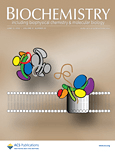
Biochemistry Research International
Scope & Guideline
Advancing biochemistry knowledge for a global audience.
Introduction
Aims and Scopes
- Biochemical Mechanisms in Health and Disease:
The journal publishes research that elucidates the biochemical pathways involved in health disorders, emphasizing the molecular basis of diseases such as cancer, neurodegenerative diseases, and metabolic disorders. - Natural Products and Phytochemistry:
A significant focus is on the extraction, characterization, and application of bioactive compounds from natural sources, including plants and microorganisms, examining their potential therapeutic effects. - Nanotechnology in Biochemistry:
Research involving the development and application of nanomaterials, particularly in drug delivery systems and biosensors, is a core area, highlighting innovative approaches to enhance therapeutic efficacy. - Proteomics and Genomics:
The journal covers studies utilizing proteomic and genomic techniques to understand complex biological systems, particularly in the context of cancer and other diseases, offering insights into biomarker discovery and therapeutic targets. - Environmental Biochemistry:
Research addressing the biochemical effects of environmental pollutants and their impact on health and ecosystems, including studies on the toxicity of chemicals and their mechanisms of action. - Clinical Biochemistry:
The journal includes studies that link biochemical findings to clinical outcomes, emphasizing the relevance of biochemical research in the development of diagnostic and therapeutic strategies.
Trending and Emerging
- Green Chemistry and Sustainable Practices:
There is an increasing focus on green synthesis methods for nanoparticles and other compounds, reflecting a broader commitment to sustainability and environmental responsibility in research. - Biochemical Mechanisms of Cancer Progression:
Research linking specific biochemical markers and pathways to cancer progression, particularly involving proteomics and bioinformatics, is gaining traction, underscoring the need for personalized medicine approaches. - The Role of Microbiota in Health and Disease:
Emerging studies on the influence of gut microbiota and other microbial communities on human health are becoming more prevalent, suggesting a growing interest in the biochemistry of host-microbe interactions. - Advanced Drug Delivery Systems:
Innovations in drug delivery systems, especially those utilizing nanotechnology and biocompatible materials, are increasingly featured, showcasing their potential to enhance therapeutic outcomes. - Neurobiochemistry and Mental Health:
Research exploring the biochemical basis of neurodegenerative diseases and psychiatric conditions is on the rise, indicating a growing intersection between biochemistry and mental health research.
Declining or Waning
- Traditional Medicinal Chemistry:
Research focused solely on traditional medicinal chemistry approaches, without integration of modern molecular biology techniques, has seen a decline, as newer interdisciplinary approaches gain traction. - Basic Biochemical Studies Without Clinical Relevance:
There is a noticeable decrease in publications centered on basic biochemical mechanisms that do not translate into clinical or practical applications, indicating a shift towards more applied research. - Single-Species Microbial Studies:
Studies focusing exclusively on single microbial species without consideration of their interactions within ecosystems or their broader implications in health and disease are becoming less common, as there is a growing interest in microbiome studies. - In Vitro Studies with Limited Contextual Relevance:
Research that presents in vitro findings without sufficient context or application to in vivo systems or clinical scenarios appears to be declining, as the journal emphasizes translational research.
Similar Journals

BIOCHEMISTRY
Advancing biochemical knowledge for a deeper understanding of life.BIOCHEMISTRY is a premier academic journal published by the American Chemical Society, dedicated to advancing the field of biochemistry through the dissemination of high-quality research. With an ISSN of 0006-2960 and an e-ISSN of 1520-4995, this esteemed publication has been a vital resource since its inception in 1962 and continues to contribute to the scientific community, boasting a remarkable Q1 ranking in the field as of 2023. The journal's well-curated content emphasizes fundamental biochemical research, molecular genetics, and innovations in biochemical techniques, catering to a diverse audience of researchers, professionals, and students. Although not an open-access publication, BIOCHEMISTRY plays a crucial role in facilitating knowledge exchange and fostering academic collaboration globally, making significant contributions to the understanding of the biochemical processes that underpin life.

APPLIED BIOCHEMISTRY AND BIOTECHNOLOGY
Innovative Insights for a Sustainable FutureApplied Biochemistry and Biotechnology is a leading journal published by Springer, dedicated to advancing research in the interdisciplinary fields of biochemistry, biotechnology, and applied microbiology. Established in 1981, this peer-reviewed journal covers a wide range of topics that encompass innovative techniques, methodologies, and applications of biochemistry and biotechnology in medicine, environmental engineering, and molecular biology. With a Q2 ranking in several categories and an increasing impact factor, the journal demonstrates significant influence and credibility within the scientific community. While traditionally subscription-based, the journal offers avenues for open access through selective agreements, making high-quality research accessible to a broader audience. Researchers, professionals, and students alike will find Applied Biochemistry and Biotechnology to be an invaluable resource for the latest developments and applications in biochemistry and its related fields, aiding in the quest for sustainable solutions and novel biotechnological advancements.

Journal of Biochemistry
Elevating the discourse in biochemistry and molecular biology.Journal of Biochemistry, published by Oxford University Press, is a prestigious academic journal that has been at the forefront of biochemical research since its inception in 1922. With an ISSN of 0021-924X and an E-ISSN of 1756-2651, this journal serves as a platform for disseminating high-quality research in the fields of biochemistry, molecular biology, and medicine, holding impressive rankings such as Q2 in Biochemistry and Medicine (miscellaneous) in 2023. As of 2024, the journal continues to explore significant topics in these areas, offering valuable insights for researchers, professionals, and students alike. The journal does not currently offer open access, but it remains a vital resource for anyone in the biochemical community seeking to stay updated on the latest discoveries and advancements. With its rich history and dedication to scientific excellence, the Journal of Biochemistry is an indispensable part of the scholarly landscape.

CHEMICO-BIOLOGICAL INTERACTIONS
Exploring the Nexus of Chemistry and BiologyCHEMICO-BIOLOGICAL INTERACTIONS is a premier journal published by Elsevier Ireland Ltd, dedicated to advancing the field of chemical and biological interactions since its inception in 1969. With a robust focus on pharmacology and toxicology, the journal holds a prestigious Q1 ranking in both Medicine (miscellaneous) and Toxicology, reflecting its significance in disseminating influential research. As part of the Scopus database, it ranks #21 out of 133 journals in Toxicology, positioning it in the 84th percentile and ensuring high visibility for cutting-edge studies. This scholarly platform serves as a crucial resource for researchers, professionals, and students who seek reliable and innovative findings at the intersection of chemistry and biology. While currently not open access, CHEMICO-BIOLOGICAL INTERACTIONS provides a comprehensive collection of articles that contribute to the ongoing dialogue in toxin research and its implications on medicinal chemistry, thereby fostering advancements in public health and safety.

IUBMB LIFE
Connecting Researchers to the Future of Life SciencesIUBMB LIFE is a prestigious, peer-reviewed journal published by WILEY, dedicated to advancing the fields of biochemistry, molecular biology, and cell biology. With an impressive impact factor and consistently ranked in the Q1 and Q2 categories across multiple relevant disciplines—including Biochemistry, Genetics, and Clinical Biochemistry—this journal has established itself as a leading platform for disseminating innovative research and critical reviews that propel scientific discovery. The journal spans a converged publication period from 1999 to 2024, providing comprehensive insights into the dynamic landscape of biochemical research. Researchers, professionals, and students alike are invited to explore its Open Access options, ensuring that groundbreaking studies are accessible to a global audience. As it continues to shape the future of life sciences, IUBMB LIFE remains a vital resource for those seeking to enrich their understanding and contribute to these rapidly evolving fields.

Annual Review of Biochemistry
Bridging Research and Discovery in Life SciencesAnnual Review of Biochemistry is a premier publication in the field of biochemistry, renowned for its comprehensive and critical reviews that collate significant advancements and insights since its inception in 1946. Published by Annual Reviews in the United States, this journal maintains a prestigious position within the academic community, boasting a Q1 ranking in the biochemistry category for 2023, with an impressive Scopus rank of #4 out of 438, placing it in the top 1% of its field. With a commitment to excellence, it serves as an essential resource for researchers, professionals, and students striving to stay at the forefront of biochemical research. While the journal does not operate on an open-access model, it continues to provide key insights and knowledge that fuel innovation and discovery in the life sciences. As it converges research from various eras up to 2024, Annual Review of Biochemistry remains a vital contributor to the development of molecular biology and genetics, catering to the needs of a diverse readership keen on advancing their understanding and expertise in biochemistry.

Turkish Journal of Biochemistry-Turk Biyokimya Dergisi
Innovative insights for a thriving biochemical community.Turkish Journal of Biochemistry-Turk Biyokimya Dergisi, published by WALTER DE GRUYTER GMBH, is a pivotal open-access journal in the field of biochemistry that serves as a forum for innovative research and scholarly discourse. Since its inception in 2009 and transitioning to open access in 2015, this journal has gained recognition within the scientific community, reflecting a commitment to advancing knowledge in biochemistry and related medical sciences. With a diverse scope that encompasses molecular biology, clinical biochemistry, and the broader arena of biochemical studies, Turkish Journal of Biochemistry offers researchers, professionals, and students access to impactful studies and current developments. Although currently positioned in the lower quartiles in specific categories, the journal aims to enhance its visibility and engagement as it converges towards a promising future, fostering collaboration and knowledge exchange among biochemists across Turkey and around the globe. This journal is vital for anyone seeking to stay abreast of emerging trends and research findings in biochemistry.

COMPARATIVE BIOCHEMISTRY AND PHYSIOLOGY B-BIOCHEMISTRY & MOLECULAR BIOLOGY
Advancing Knowledge in Comparative BiochemistryComparative Biochemistry and Physiology B: Biochemistry & Molecular Biology, published by Elsevier Science Inc, is a premier journal dedicated to the field of biochemistry and molecular biology with a specific focus on comparative analyses across various biological systems. Since its inception in 1971, the journal has made significant contributions to our understanding of the biochemical and physiological processes that differentiate organismal function across animal and aquatic life. The journal holds a commendable position in the academic community, evidenced by its 2023 rankings, which place it in the second quartile for Animal Science and Zoology and Aquatic Science, and the third quartile for both Biochemistry and Molecular Biology as well as Physiology. Researchers and students can access cutting-edge research through this highly respected publication, which continues to influence the future of biological sciences. While currently not an Open Access journal, its rigorous peer-review process ensures that only high-quality articles are disseminated, further solidifying its role as a critical resource for professionals and academics alike seeking to explore the intricate relationships between biochemical structures and physiological functions.

Biomolecules & Therapeutics
Exploring Molecular Medicine for a Healthier TomorrowBiomolecules & Therapeutics is a prominent journal published by the Korean Society of Applied Pharmacology, dedicated to advancing knowledge in the fields of Biochemistry, Drug Discovery, Molecular Medicine, and Pharmacology. With an ISSN of 1976-9148 and an E-ISSN of 2005-4483, this journal serves as a vital platform for researchers and professionals to disseminate their findings from 2008 through 2024. Ranking in the Q2 category across multiple relevant fields, including Pharmacology and Drug Discovery, and consistently placing in the 60th to 70th percentiles in Scopus rankings, Biomolecules & Therapeutics exemplifies a commitment to high-quality research and scientific integrity. Although it operates on a traditional access model, readers can be assured of the journal's rigorous peer-review process, ensuring that published articles contribute meaningfully to ongoing discourse in pharmacological and biochemical research. Located in Seoul, South Korea, the journal stands at the forefront of innovation in healthcare, making it an essential resource for academics, students, and industry professionals alike.

INDIAN JOURNAL OF BIOCHEMISTRY & BIOPHYSICS
Unlocking the secrets of life at the molecular level.INDIAN JOURNAL OF BIOCHEMISTRY & BIOPHYSICS is a well-regarded academic journal that serves as a vital platform for researchers in the fields of biochemistry and biophysics. Published by the NATL INST SCIENCE COMMUNICATION-NISCAIR since its inception in 1972, this Open Access journal has committed itself to disseminating high-quality research and advancements in these dynamic fields, allowing readers worldwide to access vital findings since 2009. The journal maintains a robust presence in the academic landscape, achieving noteworthy rankings in 2023, placing it in the Q4 category for Biochemistry and Q3 for both Biophysics and miscellaneous Medicine, alongside its respectable Scopus rankings. With an emphasis on original research articles, reviews, and educational contributions, the INDIAN JOURNAL OF BIOCHEMISTRY & BIOPHYSICS plays an essential role in fostering scientific dialogue and collaboration among professionals and students alike. For scholars seeking to stay at the forefront of biochemistry and biophysics research, this journal is an indispensable resource that fosters knowledge exchange and elevates the field on both a national and international scale.